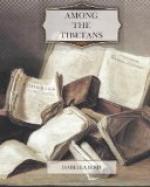The Lower Nubra valley is wilder and narrower than the Upper, its apricot orchards more luxuriant, its wolf-haunted hippophae and tamarisk thickets more dense. Its villages are always close to ravines, the mouths of which are filled with chod-tens, manis, prayer-wheels, and religious buildings. Access to them is usually up the stony beds of streams over-arched by apricots. The camping-grounds are apricot orchards. The apricot foliage is rich, and the fruit small but delicious. The largest fruit tree I saw measured nine feet six inches in girth six feet from the ground. Strangers are welcome to eat as much of the fruit as they please, provided that they return the stones to the proprietor. It is true that Nubra exports dried apricots, and the women were splitting and drying the fruit on every house roof, but the special raison d’etre of the tree is the clear, white, fragrant, and highly illuminating oil made from the kernels by the simple process of crushing them between two stones. In every gonpo temple a silver bowl holding from four to six gallons is replenished annually with this almond-scented oil for the ever-burning light before the shrine of Buddha. It is used for lamps, and very largely in cookery. Children, instead of being washed, are rubbed daily with it, and on being weaned at the age of four or five, are fed for some time, or rather crammed, with balls of barley-meal made into a paste with it.
At Hundar, a superbly situated village, which we visited twice, we were received at the house of Gergan the monk, who had accompanied us throughout. He is a zemindar, and the large house in which he made us welcome stands in his own patrimony. Everything was prepared for us. The mud floors were swept, cotton quilts were laid down on the balconies, blue cornflowers and marigolds, cultivated for religious ornament, were in all the rooms, and the women were in gala dress and loaded with coarse jewellery. Right hearty was the welcome. Mr. Redslob loved, and therefore was loved. The Tibetans to him were not ‘natives,’ but brothers. He drew the best out of them. Their superstitions and beliefs were not to him ‘rubbish,’ but subjects for minute investigation and study. His courtesy to all was frank and dignified. In his dealings he was scrupulously just. He




